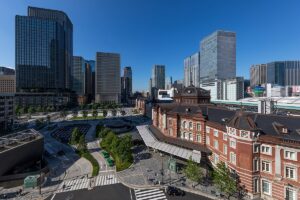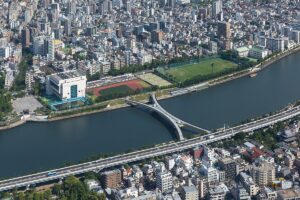Overview (history, characteristics, attractions)
Miyama Kayabuki-no-Sato (Nantan City, Kyoto Prefecture) is a satoyama village where traditional thatched-roof houses are concentrated. The landscape still retains the satoyama lifestyle and culture, and the changing appearance of the landscape with each season makes it popular with domestic and international tourists and photography enthusiasts. The village is notable for the large number of thatched-roof buildings that were once common in rural areas, all preserved together, and the landscape is protected by preservation activities and maintenance of the roofs (re-thatching work) by local residents. The idyllic rural landscape, riverside scenery, and rows of well-maintained thatched roofs are attractive.
Highlights
– A streetscape of thatched houses: As you walk through the village, you can observe up close the shape of the roofs, how they are thatched, and the smoke vents (the structure at the top of the roof).
-Scenery of the four seasons: fresh greenery and rice planting (spring), fireflies and the calm countryside of summer, autumn leaves, and snow-covered winter. You can enjoy different atmospheres in each season. The thatched roofs in the snowy scenery are especially photogenic.
– Observing traditional events and re-thatching: There are times when re-thatching work is being done, and local festivals and events are being held, allowing you to learn about local techniques and lifestyles (the dates of these events vary).
- Local food and experiences: Inside and outside the village, there may be restaurants serving local cuisine, shops selling local specialties, and accommodation and experience programs using old houses (such as soba noodle making and woodworking).
- Photo spots: There are many photo spots, such as the riverside scenery, the contrast between thatched roofs and the satoyama, and the different views during the day and at night.
Access (nearest station, transportation, etc.)
- Public transportation: The most common route is by bus from the nearest train station, Sonobe on the JR San'in Main Line, or Kameoka on the JR Sagano Line (Sanin Main Line). There are local buses to Miyama from each station, but there aren't many, so please check the timetable in advance. The nearest bus stop is "Kayabuki-no-Sato" or the nearby information stop.
- By car: Approximately 1 to 1.5 hours from Kyoto city via national and prefectural roads, and approximately 1.5 to 2 hours from the Hanshin area (depending on traffic conditions). There is a parking lot for visitors near the village.
- Sightseeing bus tours: These are sometimes included in day trips and local tours, and are convenient when public bus services are inconvenient.
– Please note: Public transport is infrequent, so plan ahead, or consider using a car or joining a tour.
Estimated stay (estimated time required)
- Quick stroll: 1-2 hours (walking around the main spots of the village and taking photos)
– Tour including meals, museum, and hands-on activities: Half day (2-4 hours)
– Stay in an old house, hike in the surrounding area, and enjoy leisurely sightseeing: 1 night (you can also enjoy the tranquil scenery the next morning)
Please adjust your stay time depending on your purpose.
Nearby spots
– Satoyama walking and hiking trails around Miyama: There are walking trails where you can enjoy nature and rural scenery.
– Local folk museums and exhibition facilities: There may be facilities that exhibit local lifestyles, agricultural tools, folk implements, etc. (Please check the facility name and opening hours in advance.)
- Nearby hot springs and day-trip bathing facilities: There are often hot springs and bathing facilities within driving distance, making them a convenient way to end your sightseeing.
– Direct sales outlets and roadside stations that sell local produce: These are places where you can buy vegetables, processed foods, local specialties, and more.
(Please check the opening hours and closing days of each facility before visiting.)
Things to be aware of (crowds, manners, seasonal precautions, etc.)
- Respect for private property and living spaces: Many thatched roof houses are residential or privately owned. Please obey signs and no-trespassing notices, do not enter the property without permission, and do not enter the gardens or eaves. Photography is generally permitted, but please respect the lives and privacy of residents (refrain from using flash, shouting, monopolizing tripods, etc.).
- Busy periods: The area is crowded on weekends, during Golden Week, during the autumn foliage season, and during the winter when the area is famous for its snowy scenery. Be aware that the parking lot may fill up, and buses may be full and you may not be able to get on.
- Transportation and timetables: There are few buses, so please check the return trip time in advance and plan your trip with plenty of time. Buses are especially limited in the evenings.
Weather and clothing: The village has unpaved, cobblestoned, and sloped roads. Comfortable walking shoes are recommended. In winter, snow accumulates and the roads freeze, so if traveling by car, please bring winter gear (studless tires, etc.). In summer, it is hot and humid and there are many mosquitoes and insects, so insect repellent is useful.
- Cash and facility information: Small shops and guesthouses may not accept credit cards, so it's a good idea to have some cash on hand. Opening times vary depending on the season and facility, so be sure to check the official website or tourist information in advance.
lastly
Miyama Kayabuki Village is a precious place where you can experience the scenery of the Satoyama and traditional life. When you visit, please not only "see, photograph, and enjoy," but also be considerate of the people who live there and be mindful of your manners, and enjoy a quiet and comfortable time.



